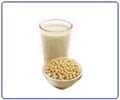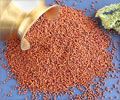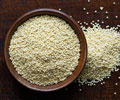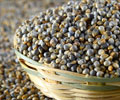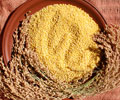Health Benefits of Millets
Barley (Hordeum vulgare)
Available as barley whole grain, barley flour, barley flour mixed with bengal gram flour.
Barley grains look like wheat grains. It is crop which easily thrives in excess heat and saline water. It is highly drought tolerant.
When the fibrous outer hull is not removed it is called as the hulled or covered barley. Once removed, it is called de-hulled or pot barley. Considered as a whole grain, de-hulled barley has its bran and germ intact and is fiber rich. pearl barley is de-hulled barley which has been further processed to remove the bran. Although pearl barley is fiber dense, ground whole barley would definitely give the added benefit of extra fiber.
De-hulled or pearl barley is further used to make barley products like barley flour, barley flakes and grits. Barley soup, stew, porridge made of barley flour is commonly eaten throughout the world. In India barley flour is commonly used and added to the daily flour. The easiest way of consuming barley is mixing barley flour with regular flour mix.
Nutritional benefits of barley:
- It contains eight essential amino acids.
- Barley is a great source of magnesium, potassium, selenium, phosphorous.
- People wanting to lose weight need to incorporate this millet in at least one of their main meals.
- It is beneficial for diabetics, people with high cholesterol and high blood pressure. Barley contains high amounts of beta-glucan, which is a form of soluble fiber. Eating barley can regulate blood sugars for up to 10 hours after consumption as compared to wheat.
Jowar (Sorghum vulgare)
Available as whole jowar, jowar flour, and as multigrain flour
Sorghum, like barley, is extremely resistant to drought. It is usually grown in dry parts of the world.
Nutritional benefits of sorghum are many:
- It is a very good source of proteins.
- It contains essential nutrients like iron, calcium, potassium, and phosphorous.
- It contains good amounts of B-vitamins like thiamin and riboflavin.
- Sorghum is rich in phytochemicals including tannins, phenolic acids and anthocyanins. Studies have shown that sorghum can reduce the risk of certain types of cancer in humans. The phytochemical levels are so high in this millet that they have shown potential usefulness in reducing obesity as well.
- Sorghum is also known to be heart healthy.
- Jowar rotis are commonly eaten in India. Jowar flour can be mixed with other flours to make multi grain flour. The flour can also be used to make pancakes, chappatis, chips and porridge.
Bajra (Pennisetum glaucum)
It is the most widely grown millet. It also survives in soils with high salinity, low soil fertility and drought.
Nutritive value of bajra:
- It is high in protein as compared to other cereals.
- It contains all essential amino acids and is particularly high in lysine, methionine, and cysteine.
- It is rich in folate, potassium, magnesium, copper, zinc and vitamin E and B-complex. It is rich in calcium and iron too.
- Bajra helps maintain cardiovascular health and helps reduce acidity problems.
- Pearl millet is consumed in the form of chappatis, bhakris (eaten in Indian states like Gujrat, Maharashtra) porridges, boiled or steamed food.
- It can be mixed with other flours to be eaten in the form of a fiber rich multigrain chappatis.
Ragi Health Benefits (Eleusine coracana)
Ragi or finger millet is available as ragi whole, ragi flour, multigrain flour, and breakfast mixes such as malted ragi flour.
Nutritional benefits of ragi:
- Ragi has a high content of protein.
- It is an extremely good source of iron and calcium.
- Ragi flour can be used to make flat breads, chappatis, dosas, idlis. Ragi grains are malted and the grains are ground. The ground flour is then mixed with milk, boiled water or yoghurt and consumed. Ragi bhakri, and ambli (a sour porridge) are popular foods in Goa and Maharashtra.
- Because of its high nutritional content ragi flour is recommended as a weaning food especially in the southern parts of India.
- The Ragi based foods are highly suited for expectant mothers and elderly due to there high calcium and iron content.
Rajgira (Amaranth seed)
It is a familiar food in India eaten on the fasting days in the form of laddus and chikkis. Recent research has revealed many health promoting facts about this wonder grain.
Nutritional benefits of amaranth seed:
- Rajgira is a very good source of protein containing 15 to 17 percent protein by weight. It is a good source of essential amino acids, especially lysine which is present in higher levels as compared to other cereals.
- It has more than 20 percent of the recommended daily amount of calcium, iron and magnesium.
- It is rich in tocotrienols and phytosterols, the two phytochemicals known to help reduce cholesterol.
- This millet is also a good source of potassium, phosphorus, vitamin A and vitamin C.
In our fast paced lives, where we need maximum fitness but really don’t have time to try innovative health recipes, the best and the easiest way to derive maximum benefit is by combining various millet flour with the standard wheat-soya flour mix to get the healthiest of foods. Refining whole wheat flour leaches out various nutrients and hence mixing other millet and pulse flours makes them wholesome. It is also a long term precautionary measure for obesity and lifestyle related health conditions.

